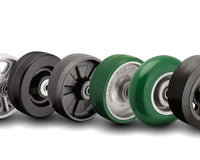We’ve all had it happen, a cart is loaded up, you go to push it, and nothing. It ended up taking a lot more force to get the cart rolling than you thought it would. It’s not an incorrect estimation on your part; it’s most likely that casters on the cart are misapplied.
Simple caster solutions
First things first, try to lighten the load. Sometimes this is easier said than done. But, when you consider the consequences of pushing too hard, it may be worth two trips. If that’s not an option, we have some alternatives.
If you can’t lighten the load, consider changing the casters, if it is an ongoing problem. Generally speaking, there are two rules of thumb with casters and wheels regarding what we call “rollability”. First, the bigger the wheel - the easier it is to push. Second, hard wheels roll better than soft wheels. So, if you’re cart has, say 4” wheels, consider going to a 6” wheel. If it has thermoplastic gray rubber wheels, consider a polyurethane tread wheel.
If you already have a big, hard wheel in the caster, it may be the bearing. Bearings, in relation to rollability, fall in this order (best to worst):
- Precision Ball Bearing
- Roller Bearing
- Delrin Bearing
- Plain Bore
- Tapered Bearing
A precision ball bearing is incredibly easy to roll, sometimes too easy. So if your casters have roller bearings, a change to a precision ball bearing may help you out.
Finally, your rigs may be overloaded; specifically the swivel rigs. Swivel sections have ball bearings and when the load is too high, the ball bearings cut into the raceway, making it hard to move; also it can permanently damage the rig. Heavier applications require heavier duty rigs.
Take a look at our whitepaper on the Ergonomics of Material Handling in our Technical Library.
If you are experiencing these problems, give our trained sales team a call at 844-863-4542. We’ll be happy to help you figure out a quick solution that will fit your budget.




